The original question was: With the current technology, it is possible now to transmute lead into gold, or whatever element into another? What transmutations should have tried the ancient Alchemist instead of the famous lead-gold one, in order to find an easy and useful success?
Physicist: Lead to gold: no. But you can change some elements into others. The yield is famously tiny, and the process is prohibitively expensive. Before the late 19th century, no body had ever observed one element turning into another, and until the 20th century there was no equipment on Earth that had the faintest prayer of successfully changing one element into another (on purpose).
Back in the day, when chemists (alchemists) were getting good at purifying samples and making fancy chemicals, they got pretty cocky about turning stuff into other stuff. But while you can use basic chemical reactions to turn hydrogen and oxygen into water, or flour and water into bread, there’s no combination of chemicals and reactions that even start to change one element into another. Alchemists back in the day, being unaware of these sorts of things, got very excited about lead-to-gold stuff, philosopher’s stones, and life from nothing. Many of them were legit scientists of the day, so we legit scientists of today have inherited a lot of their symbols and short-hand (though not their methods, by and large).
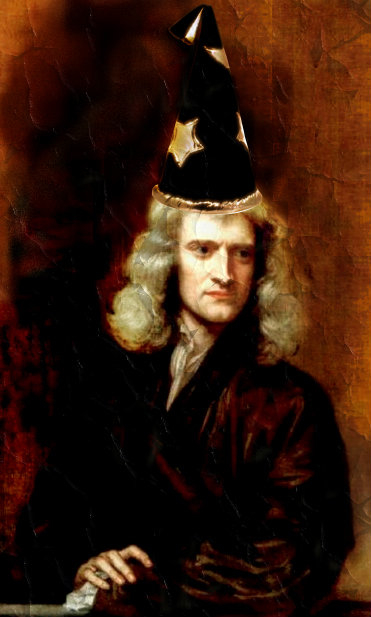
Newton loved himself some alchemy. Sure he did calculus and science, but he also did pioneering work into finding the holy grail and even a variety of crazy pursuits.
Fancy chemicals and molecules are different because they use different combinations of elements, but elements and isotopes are different from each other because they have different numbers of protons and neutrons in their nuclei.
There are basically three ways to change the number of protons and neutrons in the nucleus of an atom. Fusion, radioactive decay, and neutron bombardment.
There are some issues with practical fusion. To date we’ve managed to fuse deuterium (hydrogen) into helium, which is the easiest fusion there is, even then just barely, and only to useful effect in the middle of very big bombs. To use fusion to make gold (which is the way gold is created in nature) you need a super nova, which would probably be expensive. Also impossible.
A lot of atoms have unstable nuclei that will occasionally “pop” and turn into another element or isotope. So, technically, being patient is one way to turn a sample of some material into another.
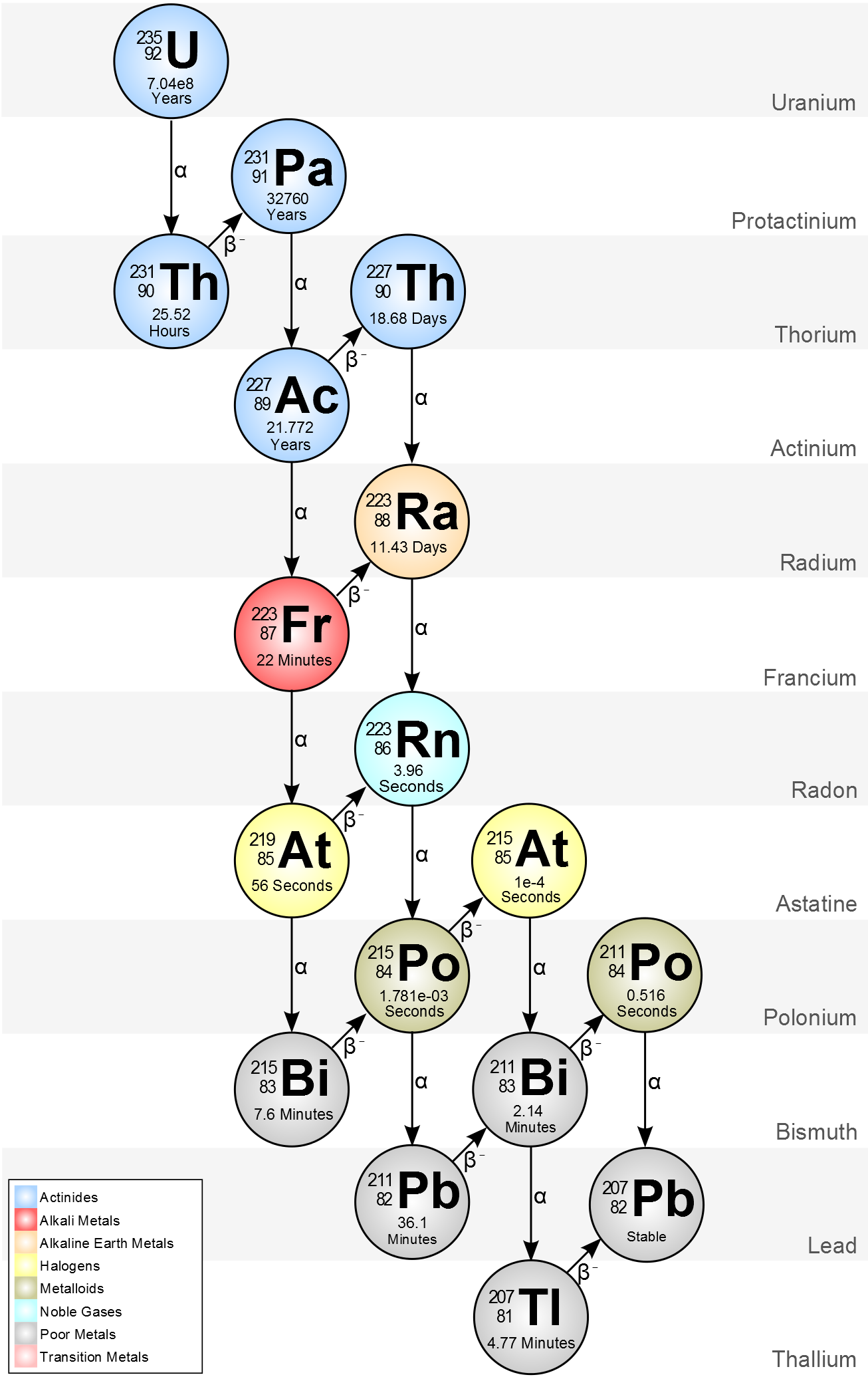
Start with some Uranium 235, then wait for several hundred million years, and you’ve got mostly lead.
Unfortunately, the material in question has to be radioactive beforehand. Radioactive atoms “decay” until the number of protons and neutrons are in balance (not equal, just balanced in a particular way), and for heavy elements that balance is almost always reached with lead or thallium.
The last way to change one isotope to another, and the only technique we can really use and control, is “neutron bombardment“. Neutron bombardment isn’t the best option, so much as it’s the only option. The idea is that since neutrons are electrically neutral (hence the name) they can enter and join the nucleus of an atom without being repelled by the positively charged nucleus (this repulsion is why this technique doesn’t work with protons, and why fusion in general is so difficult).
Bombardment is how plutonium is manufactured from uranium. Bombarding a sample with neutrons sometimes makes the atoms in question decay into higher elements, and almost always makes them more radioactive (so this is a “bombard then wait” sort of thing). In some cases it makes them so spectacularly radioactive that they immediately fly apart, and if they also produce a spray of neutrons, then you’ve got yourself the makings of a bomb or a power plant.
Here’s a map of all of the known isotopes and their preferred means of decay (many isotopes have several ways they can decay). The full chart, in detail, can be found here. It’s a very big picture.

All of the isotopes, with the number of neutrons increasing as you go to the right, and the number of protons (which is the “atomic number” or “element number”) increasing as you go up. The black squares are the stable isotopes, and this region is called the “valley of stability”.
The different colors indicate different decay paths. For example, pink is β+ decay, which turns a proton into a neutron, and an extra anti-electron, which in this case is the “radiation” we detect flying out. So, on the chart the pink isotopes decay down and to the right, by losing one proton and gaining one neutron.
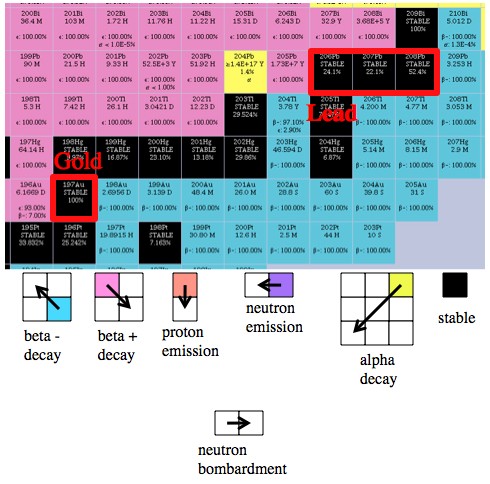
How to “play the game”. At best, we can cause a tiny fraction of a sample of an isotope to move one to the right (gain one neutron).
By looking at the chart you can figure out what elements can reasonably be made from others using neutron bombardment. For example, you might look at this little part of the chart (picture above) and think that you should be able to create gold by bombarding platinum 196 (which is directly below gold 197, the only stable gold isotope). This would add a neutron, which changes some of the sample into platinum 197, which would then execute a β– decay, moving up and to the left, and turn into gold. As it happens, this is exactly how you create gold from platinum. That β– decay has a half-life of about 20 hours, so once you irradiate your platinum you only have to wait a few days before extracting the trace amounts of gold from your sample.
There’s also an isotope of mercury, mercury 196, that can be turned into gold (it’s above and two to the left from gold 197).Lead, on the other hand, is in a bad position to form gold. Using neutron bombardment you can move to the right on the chart, but if you follow the decay path from every heavy isotope of lead, they all lead back to either lead or bismuth.
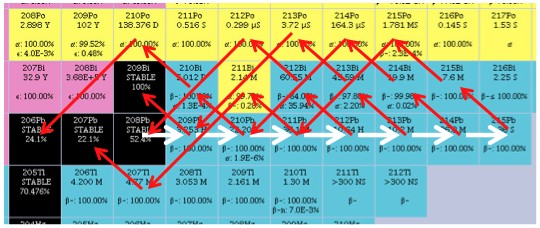
All we can do is add neutrons (white arrows), but that just takes puts us on “decay paths” that lead back to lead or bismuth.
So, using the one and only technique available to us, we definitely cannot turn lead into gold. Not even a little bit. Platinum and one fairly rare isotope of mercury, sure. But not lead.
Also, both the platinum and mercury processes are substantially more expensive and dangerous than digging gold out of the ground. Among other things you need to get your hands on a neutron source, which is generally an extremely radioactive (illegal and expensive) metal, or a multi-billion dollar accelerator used to blow apart heavy isotopes into buckets of neutrons. There are easier ways to lose money.

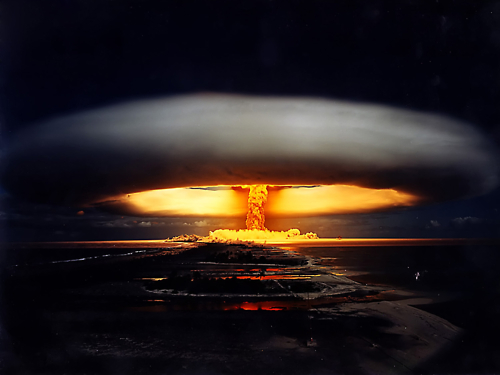






I remember reading something years ago that Seaborg had turned Bismuth into Gold. The transmutation (Lead->Bismuth->Gold) was/is prohibitively expensive for anything large scale but the post makes it sound like it is totally impossible.
I can’t seem to find the original paper, but wikipedia mentions the accomplishment, and references the original paper (it’s citation 23).
I’d never heard about that!
It looks like he did some pretty fancy tricks that came down to getting the right amount of energy (a lot for the time) into a particle beam to blow the bismuth nuclei apart. This happens naturally in spontaneous fission, but it’s impressive to see it done with lighter elements.
Pingback: Comment transformer le plomb en or ? | Pourquoi Comment Combien
Once again I’m so enthusiastic about your post that I translated it in French on my own blog ( http://drgoulu.com/2013/03/15/comment-transformer-le-plomb-en-or/ )
Thanks !
You can change gold into lead, but not the other way around!
Start with Au197 (Gold). Add 8 neutrons. Let it decay once. Add a neutron before 205Hg (mercury) decays with a half life of about 5 minutes. Then, let it decay twice. You now have 206Pb (lead)!
Unfortunately, you can’t reverse that, unless you find a way to either add a proton or subract a neutron from the lead nuclei.
-Bob
Pingback: Comment transformer le plomb en or ? | Just Science | Prenez donc un petit nuage de Science
I believe that I read inside a nuclear reactor lead has been turned into gold as a byproduct during the process. However awesome the news the down side was and still is that the gold is nuclear reactive and will remain that way for a long jesus time. Maybe someone else has heard of this story.
they actually have and do turn the mercury 196 into gold right now. it takes 24 hours and a small nuclear reactor. they bombard the mercury with neutrons or something i don’t remember the whole process its in ancient aliens (the TV show). they only make a few ounces of gold at a time though no idea why they cant or don’t make large quantity’s?? but it costs something like 200,000$ to run the reactor for 24 hours just for a few ounces of gold.
what i really wanna see is whats at the bottom of the freaking money pit.. look it up if you dont know.
Alchemy can be real today and is possible to make other things into Gold using Particle Accelerators like the ones in GSI Helmholtz , Germany.
In today’s particle accelerators we can smash particles together creating element GOLD at the rate of 2,000,000 (Two million) new Gold atoms per second.
Wait a moment before getting excited.
Given the size of one Gold atom – Even if the particle accelerator were to be kept turned continuosly ON smashing particles it would take 50 million years to create just 1 (one ) gram of GOLD.
Courtesy: VSauce
We have found that there is an unending amount of gold in each of the oceans mixed with many other elements in liquid form.
Make Hg 201 emit an alpha to go to Pt 197.
Pt 197 is unstable and will decay to Au 197 in a few hours.
Total energy balance is OK, look at the masses. You get a bit overplus energy after the process, if the tables are right.
Then again, the true alchemist wasn’t looking to make gold.
For instance, alchemist Eugenious Philalethes of the 15th century writes in Lumen de Lumin.
“They expect the proposal therefore of us, supposing we will straight way teach them to make gold by art, or supply them with ample treasure where by they may live pompously in the face of the world. Swagger and make wars, turn usurus drunkards and gluttons live unchastly and defile there whole lives….. ect..
But the perverse intentions of these fellows we do understand, out of their own writing, and by the singular grace and revelation of God, we do stop our ears and wrap ourselves as were clouds,
…. to avoid bellowings and howlings of those men who in vain cry out for Gold”.
The point is, to the philosophus paradoxus and humble spagyrist, it can be done!
Pingback: Comment transformer le plomb en or ? | Pourquoi Comment Combien
On one episode of Sesame Street, Dr. Honeydew admitted that his attempt to transmute cottage cheese into gold was a failure. However, he was able to accomplish the next best thing. He then demonstrated how he was able to morph their entire stash of gold into cottage cheese.
I was an assayer for precious metals and do not have a degree in science, chemistry or metallurgy, just a lot of experience working with assaying.
I pretty much agree with what has been said here on alchemy except that I was able to change one of the isotopes of Mercury into Au 197 without a Particle Accelerators just be using yellow cake uranium ore, but I did do some other manipulations with this process. I am not really sure how long this took because when I started the process I got really busy and came back three months later and retorted the mercury and found the gold left over. I used triple distilled Hg and then I re-did the process at a later date and produced the same results.
Sincerely, Robert
transmutation of lead to gold, copper to gold, silver to gold is possible. Forcing neutrons/protons will always gives the unstable metal.forcing this particle in body can change the human body, but not stable not in a proper way,abmormal.That the word elixir comes, which can transmute metal and does the human body. I did some experiments and succeeded. todays call is transmutation in a relatively cheap way and it does. Knowledge of metal transmutation is more valuable than gold conversion.
This article is incorrect. It IS possible to turn lead to gold as was mentioned earlier. Here is an interesting read on that: http://www.scientificamerican.com/article/fact-or-fiction-lead-can-be-turned-into-gold/
It would have been nice if this article was edited…
I seem to remember a documentary on the TV, about Chernoble , sorry don’t know how to spell it. It said, that the internal walls of the reactor had a thin coating of gold on them. I also remember that they did not advise people trying to collect it. apparently, life expectancy was zero, after two minutes of exposure, Not very long to spend your ill gotten gains. Just a matter of weeks, i suspect.
Hello,
Yes we are. Simply by molding lead into a pipe/club.
Regards, Russell Lee
If you could turn lead into gold by some simple, easy process, gold would become virtually worthless not worth more than lead, immediately. That removes the incentive to do it if there were no other reasons it can’t be done easily.